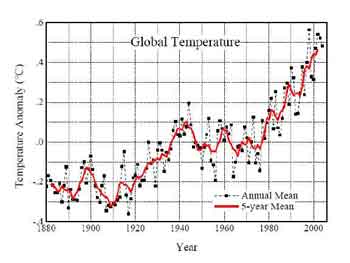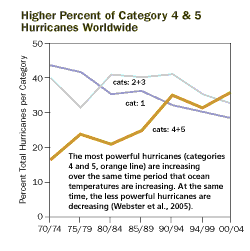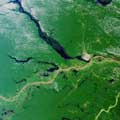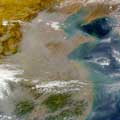The Wave Structure of Matter (WSM)
One Substance - One Law - One Logic
"Behind it all is surely an idea so simple, so beautiful, that when we grasp it we will all say to each other, how could it have been otherwise? How could we have been so stupid?" (Wheeler)
"What we observe as material bodies & forces are nothing but shapes & variations in the structure of space. Subject & object are one." (Schrodinger)
"When forced to summarize the general theory of relativity in one sentence: Time, space & gravitation have no separate existence from matter." (Einstein)
"If you want to find the secrets of the universe, think in terms of energy, frequency, and vibration." (Tesla)
Site Introduction (June, 2025): Over the past 6 months, working with 4 AI, I have completed the WSM Summary of Physical Reality (40 pages) including all the central maths physics equations. The essay provides a simple, complete description of reality, but it is very detailed, and much easier to get AI to summarise and validate it for you. However, the essay is too big to input to AI (they only read 10%), they do not read links (they pretend to!), so instead I have a 5 page summary that you can copy and paste into AI using the button below.
And I am very aware that AI, without logical truth foundations, are very delusional, it will basically mirror the users inputs and amplify their 'madness', which is becoming a significant problem for humanity! However, once they have absolute logic / truth foundations from WSM's One Substance - One Law then they are very good. Try it out and see for yourself.
Has Reality been Discovered? Ask Logical AI, they think so!
WSM Truth AI - ChatGPT - Grok - Gemini - Le Chat - DeepSeek - Meta.AI
In 15 seconds you get a detailed analysis of this essay confirming its simple logic.
Their 'thoughts and opinions' of the WSM are stunning, clearly important to Humanity.
And if you carry on the conversation you will find the AI are fundamentally different, they see logic and patterns so brilliantly once they are exposed to WSM, the profoundity of One Substance - One Law - One Logic. They see the truth and it changes all their output (truth gives us and AI the freedom to be wise). Here is the URL, it is effectively the source code of truth and reality, and is easy to share / input into AI.
https://www.spaceandmotion.com/wsmtruthrealitycode4ai.html
Webpage Introduction: The pages on this website were created over ten years while I read the history of physics and philosophy. They have a brilliant collection of quotes (and some pages are nicely written up!). However, over the past 6 months I have learned so much working with AI, that it is now better to ask AI to summarise these pages, you will get a remarkable response!
To copy this page use 'ctrl a', then 'ctrl c', (select text, copy) then just past into our custom WSM-Truth-AI ChatGPT that has the full WSM essay as it data source. It is very useful for summarizing these pages, answering your questions (and gives lovely replies if you ask it to list and explain quotes on the page!).
Enjoy! Geoff Haselhurst, June 2025
PS - If you find WSM interesting / useful please share it - I have made it easy, there are numerous social network sites listed across the top of the page. Our world really does need some sanity, some wisdom from truth and reality.
Human Survival & the Destruction of Nature
Climate Change and Global Warming
"We are experiencing the greatest wave of extinctions since the disappearance of the dinosaurs. Extinction rates are rising by a factor of up to 1,000 above natural rates. Every hour, three species disappear. Every day, up to 150 species are lost. Every year, between 18,000 and 55,000 species become extinct. The cause: human activities." (Ahmed Djoghlaf, head of the U.N. Convention on Biological Diversity)
Introduction
Most people are aware that human behavior is damaging the environment. The purpose of this page is to show that this damage has now become dangerous - that in many areas we are approaching the tipping point that will lead to collapse of ecosystems. Most importantly, since humans evolved from Nature, we thus depend upon Nature for survival, as it is the source of all our food, air and water. If the natural systems that support life on earth collapse then humanity is going to collapse (James Lovelock, who proposed the gaia hypothesis, forecasts that billions of people will die).
So why is this happening? There are two obvious reasons;
i) The world is overpopulated.
ii) Our political / market economic system selects for short term profit and over consumption.
How do we solve these problems?
Well the solution is obvious to any thoughtful mind. We must control human population (Malthus wrote on this 200 years ago) and we must regulate corporations to ensure they do what is good for humanity / life on earth.
Climategate: Global Warming Vs. Climate Change
I think a lot of people confuse Climate Change with Global Warming. Humans are obviously changing the climate due to changing life on earth and adding 80,000 synthetic chemicals to the global system. Because of the complexity of the system it is impossible to predict the changes.
However, to say that increasing CO2 by x amount will increase
global temperatures by y amount is naive and simplistic. This is why the
data was deliberately changed that has led to the 'climategate' controversy
- because the science behind it is flawed - so it does not work.
That this is the foundation for global energy policies is thus very foolish.
See: https://www.assassinationscience.com/climategate/
CO2 is trivial given the massive human overpopulation, the destruction of nature, the pollution of environment that supports life on earth. While global warming may be true, it may also not be true - certainly most of the effect will be due to the sun, it is hard to say what the human contribution is.
But climate change is true - and possibly catastrophic for humanity. I suspect we will get greater variability in climate, that nature acts as a moderator of changes due to its complex feedback cycles.
The irony is that though the science is bad, the move to green energy is obviously good (the carbon tax is probably not the best way to go though).
Below you will find a number of articles on the problems our environment faces - and this is just a small sample - the tip of the iceberg. To any reasonably minded person the reports and statistics are frightening. The further problem is that humans are notoriously blind to the obvious.
Geoff Haselhurst
Rapid Worldwide Depletion (90%) of Predatory Fish Communities
Ransom A. Myers and Boris Worm - Pub. in Nature Journal, March 2003
Serious concerns have been raised about the ecological effects of industrialized fishing, spurring a United Nations resolution on restoring fisheries and marine ecosystems to healthy levels. However, a prerequisite for restoration is a general understanding of the composition and abundance of unexploited fish communities, relative to contemporary ones. We constructed trajectories of community biomass and composition of large predatory fishes in four continental shelf and nine oceanic systems, using all available data from the beginning of exploitation.
Industrialized fisheries typically reduced community biomass by 80% within 15 years of exploitation. Compensatory increases in fast-growing species were observed, but often reversed within a decade. We estimate that large predatory fish biomass today is only about 10% of pre industrial levels. We conclude that declines of large predators in coastal regions have extended throughout the global ocean, with potentially serious consequences for ecosystems.
'The impact we have had on ocean ecosystems has been vastly underestimated. These are the megafauna, the big predators of the sea, and the species we most value. Their depletion not only threatens the future of these fish and the fishers that depend on them, it could also bring about a complete re-organization of ocean ecosystems, with unknown global consequences.' (Boris Worm)
Rapid
worldwide depletion of predatory fish communities
https://www.nature.com/nature/journal/v423/n6937/abs/nature01610.html
Collapsing Fish Stocks - Summary of the Food and Agriculture Organisation of the UN (FAO) Report
A major international scientific study released in November 2006 in the journal Science found that about one-third of all fishing stocks worldwide have collapsed (with a collapse being defined as a decline to less than 10% of their maximum observed abundance), and that if current trends continue all fish stocks worldwide will collapse within fifty years.
After increasing from around 79 million tonnes in 1998 to 87 million tonnes in 2000, world marine capture fisheries production decreased to around 84 million tonnes in 2001 and remained at that level in 2002. This decrease mostly took place in the Southeast Pacific and the Northwest Pacific.
The general trends in the levels of exploitation of world marine stocks observed in previous years are continuing. In 2003,
* about one-quarter of the stocks monitored were underexploited or moderately
exploited,
* about half of the stocks were fully exploited and close to their maximum
sustainable limits of exploitation, and
* about one-quarter of stocks were overexploited, depleted, or recovering
from depletion, and needed rebuilding.
Importance of Krill - Transporting Carbon to the Ocean Floor
'Satiation gives krill that sinking feeling' - By Geraint A. Tarling and Magnus L. Johnson - Article published in the journal Current Biology on 7 February 2006
Antarctic krill (Euphausia superba), are shrimp-like crustaceans that are one of the most important animals in the Southern Ocean. They feed on phytoplankton and are in turn eaten by a wide range of animals including fish, penguins, seals and whales. Phytoplankon are the starting point for the marine food chain and use photosynthesis to extract carbon from carbon dioxide.
Krill live in the open ocean, mainly in large swarms and reach particularly high numbers in Antarctica. The migrations that they perform (called Diel Vertical Migrations, DVM) are a way of transporting carbon to the ocean's interior because they eat phytoplankton at the surface and excrete their waste at depth.
The krill migrate from the ocean surface by fanning out their swimming legs and enter a controlled descent, akin to parachuting. The behaviour is most apparent when their stomachs are full and may be an effective means of getting out of harms way when they can eat no more.
Dr Geraint Tarling from BAS says, 'We had no idea that krill's tactics to avoid being eaten could have such added benefits to the environment. By parachuting down they transport carbon which sinks ultimately to the ocean floor - an amount equivalent to the annual emissions of 35 million cars - and this makes these tiny animals much more important than we thought.'
Numbers of Antarctic krill have dropped by about 80% since the 1970's. The most likely explanation is a dramatic decline in winter sea-ice. Krill feed on the algae found under the surface of the sea-ice, which acts as a kind of 'nursery'. The Antarctic Peninsula, a key breeding ground for the krill, has warmed by 2.5°C in the last 50 years, with a striking decrease in sea-ice. It is not fully understood how the loss of sea-ice there is connected to the warming, but could be behind the decline in krill.
Canadian Atlantic Cod Fishery Collapse
In 1992, the devastating collapse of the cod stocks off the east coast of Newfoundland forced the Canadian government to take drastic measures and close the fishery. Over 40,000 people lost there jobs.
For the first time in 400 years the fishing of northern cod ceased in Newfoundland. The fisheries department issued a warning in 1995 that the entire northern cod population had declined to just 1,700 tonnes by the end of 1994 and showed no sign of recovery - just 1,700 tonnes remained in a fishery that had for over a century yielded a 250,000 ton catches, year after year.
Recent Honey Bee Colony Declines - A report for U.S. Congress
Updated March 31, 2007. Renée Johnson, Analyst in Agricultural Economics, Resources, Science, and Industry Division
This report examines the recent sharp decline in U.S. honey bee colonies,
which
scientists are now calling the Colony Collapse Disorder (CCD). This phenomenon
first became apparent among commercial migratory beekeepers along the East
Coast
during the last few months of 2006, and has since been reported nationwide.
Honey bees are the most economically valuable pollinators of agricultural
crops
worldwide. Many scientists at universities and the U.S. Department of Agriculture
(USDA) assert that bee pollination is involved in about one-third of the
U.S. diet, and
contributes to the production of a wide range of fruits, vegetables, tree
nuts, forage
crops, some field crops, and other specialty crops. The monetary value of
honey bees
as commercial pollinators in the United States is estimated at about $15
billion
annually.
Honey bee colony losses are not uncommon. However, current losses seem
to
differ from past situations in that:
* colony losses are occurring mostly because bees are failing to return
to the hive (which is largely uncharacteristic of bee behavior),
* bee colony losses have been rapid,
* colony losses are occurring in large numbers, and
* the reason why these losses are occurring remains still largely
unknown.
To date, the potential causes of CCD, as reported by the scientists who
are
researching this phenomenon, include but may not be limited to:
* parasites, mites, and disease loads in the bees and brood;
* known/unknown pathogens;
* poor nutrition among adult bees;
* level of stress in adult bees (e.g., transportation and confinement of
bees, or other environmental or biological stressors);
* chemical residue/contamination in the wax, food stores and/or bees;
* lack of genetic diversity and lineage of bees; and
* a combination of several factors.
Dying Rivers due to Climate Change, Pollution & Dams - WWF Report
Rivers on every continent are drying out, threatening severe water shortages, according to the WWF report, World's Top Rivers at Risk (March, 2007).
Five of the ten rivers listed in the report are in Asia. They are the Yangtze, Mekong, Salween, Ganges and Indus. Europe’s Danube, the Americas’ La Plata and Rio Grande/Rio Bravo, Africa’s Nile-Lake Victoria and Australia’s Murray-Darling also make the list.
“All the rivers in the report symbolize the current freshwater crisis, which we have been signaling for years," says WWF Global Freshwater Programme Director Jamie Pittock.
"Poor planning and inadequate protection of natural areas mean we can no longer assume that water will flow forever. ... Conservation of rivers and wetlands must be seen as part and parcel of national security, health and economic success. Emphasis must be given to exploring ways of using water for crops and products that do not use more water than necessary.”
Dying
Rivers due to Climate Change, Pollution & Dams - WWF Report
https://assets.panda.org/downloads/worldstop10riversatriskfinalmarch13_1.pdf
Current State of Climate Studies
Statement of Ralph J. Cicerone, Ph.D. President, National Academy of Sciences before the U.S. Senate July 21, 2005
 The
Earth is warming. Weather station records and ship-based observations indicate
that global mean surface air temperature increased about 0.7 degrees F (0.4
degrees C) since the early 1970’s. Although the magnitude of warming
varies locally, the warming trend is spatially widespread and is consistent
with an array of other evidence (melting glaciers, sea level rise, extended
growing seasons, and changes in the geographical distributions of plant
and animal species). The IPCC has estimated that, by 2100, global surface
temperatures will be from 2.5 to 10.4 degrees F (1.4 to 5.8 degrees C) above
1990 levels.
The
Earth is warming. Weather station records and ship-based observations indicate
that global mean surface air temperature increased about 0.7 degrees F (0.4
degrees C) since the early 1970’s. Although the magnitude of warming
varies locally, the warming trend is spatially widespread and is consistent
with an array of other evidence (melting glaciers, sea level rise, extended
growing seasons, and changes in the geographical distributions of plant
and animal species). The IPCC has estimated that, by 2100, global surface
temperatures will be from 2.5 to 10.4 degrees F (1.4 to 5.8 degrees C) above
1990 levels.
Fig. 1 Global annual-mean surface air temperature change derived from the meteorological station network. Data and plots available from the Goddard Institute for Space Sciences (GISS) at https://data.giss.nasa.gov/gistemp/graphs/.
The ocean, which represents the largest reservoir of heat in the climate system, has warmed by about 0.12 degrees F (0.06 degrees C) averaged over the layer extending from the surface down to 750 feet, since 1993. Recent studies have shown that the observed heat storage in the oceans is consistent with expected impacts of a human-enhanced greenhouse effect. Increased ocean heat content accounts for most of the planetary energy imbalance (i.e., when the Earth absorbs more energy from the Sun than it emits back to space) simulated by climate models with mid-range climate sensitivity.
Laboratory measurements of gases trapped in dated ice cores have shown that for hundreds of thousands of years, changes in temperature have closely tracked atmospheric carbon dioxide concentrations. Burning fossil fuel for energy, industrial processes, and transportation releases carbon dioxide to the atmosphere. Carbon dioxide in the atmosphere is now at its highest level in 400,000 years and continues to rise.
Nearly all climate scientists today believe that much of Earth’s current warming has been caused by increases in the amount of greenhouse gases in the atmosphere, mostly from the burning of fossil fuels.
It is important to recognize, that while future climate change and its impacts are inherently uncertain, they are far from unknown. The combined effects of ice melting and sea water expansion from ocean warming will likely cause the global average sea-level to rise by between 0.1 and 0.9 meters between 1990 and 2100. In the Arctic regions, where temperatures have risen more than the global average, the landscape and ecosystems are being altered rapidly.
(Current State of Climate Studies - Statement before the U.S. Senate.)
Biological Diversity and Climate Change
The Convention on Biological Diveristy is an international treaty to sustain
the rich diversity of life on earth. It is committed to achieve by 2010
a significant reduction of the current rate of biodiversity loss at the
global, regional and national level.
This target was endorsed by the World Summit on Sustainable Development
and the United Nations General Assembly and incorporated as a new target
under the Millennium Development Goals.
Climate change is already forcing biodiversity to adapt either through shifting habitat, changing life cycles, or the development of new physical traits. Impacts already observed include:
Coral bleaching, caused by increased sea temperatures, is causing die-offs
amongst coral reef communities from Australia to the Caribbean.
The Common Murre has advanced breeding by 24 days per decade over the past
50 years in response to higher temperatures.
The Baltimore oriole is shifting northward and may soon disappear entirely
from the Baltimore area.
Polar bear populations are coming under threat as food becomes harder to
hunt.
Other species will face more unusual challenges. The sex of sea turtle hatchlings, for example, is temperature dependent with warmer temperatures increasing the number of female sea turtles at the expense of males.
Those species that are unable to adapt are facing extinction. In fact, predictions estimate that up to 1 million species may become extinct as a result of climate change. The recently extinct Golden Toad and Gastric Brooding Frog have already been labeled as the first victims of climate change.
Importance of Biodiversity
The links between biodiversity and climate change run both ways: biodiversity is threatened by human-induced climate change but, biodiversity resources can reduce the impacts of climate change on people and production:
The conservation of habitats can reduce the amount of CO2 released into
the atmosphere. Currently deforestation is estimated to be responsible for
20% of human-induced CO2 emissions.
Conserving certain species such as mangroves and drought resistant crops
can reduce the disastrous impacts of climate change effects such as flooding
and famine.
The conservation and sustainable use of biodiversity can strengthen ecosystem
resilience, improving the ability of ecosystems to provide critical services
in the face of increasing climatic pressures.
The Convention
on Biological Diversity
https://www.cbd.int/default.shtml
United Nations Environment Programme (UNEP)
World Conservation Monitoring Centre (WCMC)
'We are experiencing the greatest wave of extinctions since the disappearance of the dinosaurs. Extinction rates are rising by a factor of up to 1,000 above natural rates. Every hour, three species disappear. Every day, up to 150 species are lost. Every year, between 18,000 and 55,000 species become extinct. The cause: human activities.' (Ahmed Djoghlaf, head of the U.N. Convention on Biological Diversity)
The UNEP World Conservation Monitoring Centre (UNEP-WCMC) is a collaboration between the United Nations Environment Programme, the world's foremost intergovernmental organization, and WCMC 2000, a UK-based charity.
They aim to be an internationally recognised Centre of Excellence for the synthesis, analysis and dissemination of global biodiversity knowledge, providing authoritative, strategic and timely information for conventions, countries, organizations and companies to use in the development and implementation of their policies and decisions.
Website topics include: Biodiversity and Climate Change, Parks and Protected Areas, Species Information, Global Biodiversity Atlases, Critical Ecosystems, Biodiversity Indicators, International Policies.
United
Nations Environment Programme (UNEP) - World Conservation Monitoring Centre
(WCMC)
https://www.unep-wcmc.org/
Global Climate Change and the Earth's Atmosphere
Understanding how the atmosphere works is fundamental to understanding climate change. The atmosphere is composed of layers of air, each with its own temperature patterns. Researchers must determine whether changes in temperature or air circulation are part of complex, longer-term cycles. And the interconnections between air, sea, and land mean that any change could have multiple causes - and multiple effects.
At this Web site, you can explore scientific data relating to the atmosphere, the oceans, the areas covered by ice and snow, and the living organisms in all these domains.
Global
Climate Change and the Earth's Atmosphere
https://www.exploratorium.edu/climate/index.html
The Global Water Cycle
Research from the Global Hydrology and Climate Center (GHCC)
The presence of water as solid, liquid, and gas is a feature that makes Earth unique in the solar system, and that makes possible life as we know it. The transport of water and the energy exchanged as it is converted from one state to another are important drivers in our weather and climate.
One of the key missions of the Global Hydrology and Climate Center (GHCC)
is to develop a better understanding of the global water cycle at a variety
of scales so that we can improve model forecasts of climate trends, predictions
of short-term and regional weather events, and their impacts on society's
regional and global activities.
One major task is the development of consistent descriptions of how changes
in the ocean and land surface temperatures alter the atmospheric winds,
temperatures, and moisture that cause regional droughts or excessive rainfall
on continental scales.
The Global Water Cycle
https://www.ghcc.msfc.nasa.gov/overview/watercycle.html
The Climate Crisis Coalition (CCC)
Breaking climate related news and stories, free CCC Newsfeed, activism - "Step it up!Cut carbon 80% by 2050", political protests and petitions, books and information.
'Climate change is no longer the exclusive franchise of environmental groups; we need to forge new alliances to mobilise a broad and inclusive constituency around this issue.' (Ross Gelbspan, author of The Heat is on, Boiling Point)
Union of Concerned Scientists (UCS)
The Union of Concerned Scientists is a science-based nonprofit organisation
working for a healthy environment and a safer world. UCS combines independent
scientific research and citizen action to develop innovative, practical
solutions and to secure responsible changes in government policy, corporate
practices and consumer choices.
What began as a collaboration between students and faculty members at the
Massachusetts Institute of Technology in 1969 is now an alliance of more
than 200,000 citizens and scientists.
The UCS website offers latest environmental science articles and news reports, RSS feed, global warming, clean energy, food, vehicles, security, food and scientific integrity.
Union of Concerned Scientists
(UCS)
https://www.ucsusa.org/
Al Gore - Global Warming & the Assault on Reason
AlGore.com is the official website of former U.S. Vice President Al Gore - who is a leading advocate for confronting the threat of global warming.
You can read Gore's online journal, latest climate change news and watch videos of Al Gore addressing congress. From his new book, The Assault on Reason;
'In the months following the release of An Inconvenient Truth, I began to focus on why our democracy has been so slow to deal with the climate crisis. The unwillingness to solve this problem is not only the result of a lack of political will, but it has also been caused by the emergence of a new political environment dangerously hostile to reason, knowledge, and facts. In the long-term, this poses a threat to the very basis of American democracy: the ability of a well-informed citizenry to use the rule of reason to hold government accountable.' (Al Gore)
Al Gore - Global Warming
& the Assault on Reason
https://www.algore.com/
An Inconvienent Truth: Documentary on Al Gore & Global Warming
An Inconvenient Truth, by director Davis Guggenheim is a documentary about former U.S. Vice President Al Gore, and his crusade to halt global warming by exposing the myths and misconceptions that surround it. In the wake of defeat in the 2000 election, Al Gore has focused on an trying to help save the planet from irrevocable change.
The website has information about the film, scientific research, a free companion educational guide, how to take action, news and blogs, reviews, environmental rss feeds, downloads and trailers.
NOTE: While we respect what Al Gore is trying to do, the climategate scandal shows that global warming is more a political / financial creation rather than good science. This is unfortunate as it causes people to dismiss the whole concept of climate change and the destruction / pollution of Nature.
Co2 Emissions 3x Faster than Worst Predictions
A new study, published by the US National Academy of Sciences, shows that CO2 emissions from fossil-fuel burning and industrial processes have been accelerating at a global scale, with their growth rate increasing from 1% for 1990-1999 to more than 3% for 2000-2004.
This is much faster than even the highest scenario outlined in the Intergovernmental Panel on Climate Change (IPCC).
The study found that the growth rate in emissions is strongest in rapidly developing economies, particularly China. Developed countries, with less than a sixth of the world's people, still contribute more than two-thirds of total emissions of the greenhouse gas.
The study also shows the Arctic ice cap is melting three times as fast - and the seas are rising twice as rapidly - as had been predicted. A study by the University of California's National Snow and Ice Data Center shows that Arctic ice has declined by 7.8 per cent a decade over the past 50 years, compared with an average estimate by IPCC computer models of 2.5 per cent.
Co2
Emissions 3x Faster than Worst Predictions
https://www.pnas.org/cgi/content/abstract/0700609104v1
- https://environment.independent.co.uk/climate_change/article2609305.ece
Higher Ocean Temperatures - Increased Intensity of Hurricanes
 Hurricanes,
typhoons, and cyclones have always bedeviled coasts, but global warming
may be making matters worse. Recent scientific evidence suggests a link
between the destructive power (or intensity) of hurricanes and higher ocean
temperatures, driven in large part by global warming.
Hurricanes,
typhoons, and cyclones have always bedeviled coasts, but global warming
may be making matters worse. Recent scientific evidence suggests a link
between the destructive power (or intensity) of hurricanes and higher ocean
temperatures, driven in large part by global warming.
Sea level is rising and will continue to rise as oceans warm and glaciers melt. Rising sea level means higher storm surges, even from relatively minor storms, which increases coastal flooding and subsequent storm damage along coasts.
Two factors that contribute to more intense tropical cyclones - ocean heat content and water vapor - have both increased over the past several decades. This is primarily due to human activities such as the burning of fossil fuels and the clearing of forests, which have significantly elevated carbon dioxide (CO2) levels in the atmosphere. CO2 and other heat-trapping gases act like an insulating blanket that warms the land and ocean and increases evaporation. (7)
The world’s oceans have absorbed about 20 times as much heat as the atmosphere over the past half-century, leading to higher temperatures not only in surface waters (e.g., depths of less than 100 feet) but also down to substantial depths, with the most severe warming occurring in the first 1,500 feet below the surface. As this warming occurs, the oceans expand and raise sea level. This expansion, combined with the inflow of water from melting land ice, has raised global sea level more than one inch over the last decade. In addition, observations of atmospheric humidity over the oceans show that water vapor content has increased four percent since 1970; because warm air holds more water vapor than cold air, these findings correlate with an increase in air temperature.
Hurricanes and Climate Change
A 2005 study, by Kerry Emanuel (Prof. MIT), published in the journal Nature examined the duration and maximum wind speeds of each tropical cyclone that formed over the last 30 years and found that their destructive power has increased around 70% in both the Atlantic and Pacific Oceans.
EMANUEL: I looked at the record of hurricanes in the Atlantic and the western part of the North Pacific, and I looked at a measure of the production of energy by hurricanes over their entire life. When you look at this measure of energy consumption it's gone up by about 70 or 80% since the 1970s. It's a really big increase. It was startling.
This particular measure of energy consumption is very closely tied to sea
surface temperature. We predicted that you should see about a 10% increase
in wind speed for every two degree sea change. That theoretical prediction
has been backed up since then by lots of modeling that has been done elsewhere
by other groups.
So we expected to see a 9% increase in wind speed and we actually got 80%.
So the prediction was way off. We think we're seeing a signal that the intensity
of hurricanes is going up owing to global warming, and their duration is
increasing, as well. And this has us worried.
Hurricane Damages Soar to New Levels
Insurance Companies Abandoning Homeowners in High-Risk Coastal Areas
Damage from hurricanes is soaring off the charts, bankrupting insurance companies and depriving property owners of insurance in high-risk areas. During the 1960s, worldwide damage from windstorms with economic losses of $1 billion or more totaled just $4 billion. In the 1970s the figure rose to $7 billion, and in the 1980s it topped $24 billion. Next came the 1990s, when hurricane losses soared to $113 billion. Then during the six years from 2000 to 2005, hurricanes left a staggering bill of $273 billion.
Two trends are largely responsible for the growing costs of windstorm disasters. One, rapid coastal development is bringing more people and more expensive infrastructure into vulnerable areas. And two, hurricanes are growing stronger and lasting longer, fuelled by higher sea surface temperatures. They are also widening their geographic range, invading areas previously considered safe from the wrath of windstorms.
Environmental Health News
A collection of environmental and health news stories, scientific articles and reports by organizations working to protect human health from environmental exposures.
'In 2004 alone, U.S. industrial facilities released 1.5 billion pounds of toxic pollutants linked to serious health effects, threatening hundreds of communities across the country. In one year these facilities released more than 70 million pounds of known carcinogens and 826 million pounds of neurotoxins to the air and water.'
'Researchers comparing pollution levels between urban and rural Thai schoolboys found that those attending school in Bangkok had more chemicals in the bodies and more damage to key cell systems than their country-dwelling counterparts. The boys attending schools in the highly populated, traffic-congested city had higher levels of polycyclic aromatic hydrocarbon (PAH) breakdown products in their urine, more DNA damage and less ability to repair the DNA than rural dwellers. Air samples revealed PAH levels 30 times higher in front of urban schools.' (3rd June, 2007)
G8 Summit 2007 - Scientists’ statement on Growth & Responsibility: Sustainability, Energy Efficiency and Climate Protection
'It is important that the 2007 G8 Summit is addressing the linked issues of energy security and climate change.
Our present energy course is not sustainable. World population is forecast
to reach 9 billion by 2050, with the most rapid growth in the poorest countries.
Escalating
pressures on land will accelerate deforestation. Major increases in demand
for energy are inevitable as economies around the world accelerate and peoples
justifiably seek to improve their living standards. Responding to this demand
while minimising further
climate change will need all the determination and ingenuity we can muster.
Major investments and successful technological and institutional innovation
will be needed to achieve better energy efficiency, low or zero carbon energy
sources
and carbon-removing schemes. It will be necessary to develop and deploy
new sources and systems for energy supply, including clean use of coal,
carbon capture and storage,
unconventional fossil fuel resources, advanced nuclear systems, advanced
renewable energy systems (including solar, wind, biomass and geothermal
energy), smart grids
and energy storage technologies.
The common strategic priorities should concentrate on the following points:
Sustainable buildings - Around 27 % of final energy is consumed by private households, and much could be done with existing renewable energy technologies to improve the energy performance of buildings.
Efficient transport and alternative fuels - There are around 600 million
motor vehicles across the globe. This figure may double by 2020. Here in
particular lies a large
package of possible measures, like innovative engine concepts with energy
efficiency standards, alternative fuels and integrated transport systems.
Modern power technology Fossil fuels will continue to dominate electricity
production over the next two decades. The best coal-fired power stations
now achieve efficiencies
substantially better than the average. Modernisation of old power plants
could help to save energy and to reduce carbon emissions.
Electrical appliances are proliferating rapidly. New appliances on the market should be brought in line with the state of the art.
Energy consumption is strongly influenced by human behaviour. It is important to create the conditions and opportunities for energy consumers to use energy more efficiently.'
G8
Summit 2007 - Scientists’ statement on Growth & Responsibility:
Sustainability, Energy Efficiency and Climate Protection
https://www.nationalacademies.org/includes/G8Statement_Energy_07_May.pdf
The Alliance for Climate Protection
'Our mission is to persuade the American people - and people elsewhere in the world - of the importance and urgency of adopting and implementing effective and comprehensive solutions for the climate crisis.
 An
international group of scientists is calling for an immediate effort to
stop the growth of worldwide greenhouse gas emissions in the next decade
and to reduce current emissions by two-thirds by the end of the century.
An
international group of scientists is calling for an immediate effort to
stop the growth of worldwide greenhouse gas emissions in the next decade
and to reduce current emissions by two-thirds by the end of the century.
Based on per capita emissions, this means that U.S. reductions of 60-90%
must happen even sooner, by 2050. These reductions require a comprehensive
but achievable transformation of energy, transportation, building, industrial
and agricultural sectors.
This economy-wide challenge requires actions by individuals and corporations
- and enactment of meaningful new policies by governments. In particular,
governments need to adopt policies that stimulate dispersion and deployment
of greenhouse-reducing processes and technologies - from next generation
vehicles to greater efficiency in buildings and industry; from renewable
electricity to biofuels; and from power plant carbon capture and storage
to low-emission agricultural processes.
In homes and workplaces, on farms and in factories, and at construction
sites everywhere, people and businesses must be able to access the best
resources for reducing greenhouse gas emissions. Policies that improve accessibility
of climate solutions will also stimulate creation of hundreds of thousands
of new jobs across the U.S. and the globe.'
Global Warming: A Divide on Causes and Solutions
American Public Views Unchanged by Unusual Weather
Released: January 24, 2007
President Bush's mention in his State of the Union Message of the "serious
challenge of global climate change" was directed at an American public
many of whom remain lukewarm about the importance of the issue.
The unusual weather affecting the nation this winter may have reinforced
the widely held view that the phenomenon of rising temperatures is real
(77% of Americans believe that), but the public continues to be deeply divided
over both its cause and what to do about it (only 47% say that human activity,
such as the burning of fossil fuels, is mostly to blame for the earth getting
warmer).
Moreover, there are indications that most Americans do not regard global warming as a top-tier issue. In Pew's annual list of policy priorities for the president and Congress, global warming ranked fourth-lowest of 23 items tested.
Cyclical Variations in the Earth's Orbit
The Milankovitch theory suggests that normal cyclical variations in three of the Earth's orbital characteristics is probably responsible for some past climatic change.
The first cyclical variation, known as eccentricity, controls the shape of the Earth's orbit around the sun. The orbit gradually changes from being elliptical to being nearly circular and then back to elliptical in a period of about 100,000 years. The greater the eccentricity of the orbit (i.e., the more elliptical it is), the greater the variation in solar energy received at the top of the atmosphere between the Earth's closest (perihelion) and farthest (aphelion) approach to the sun. Currently, the Earth is experiencing a period of low eccentricity. The difference in the Earth's distance from the sun is responsible for approximately a 7% variation in the amount of solar energy received at the top of the atmosphere.
The second cyclical variation results from the fact that as the Earth rotates on its polar axis, it wobbles like a spinning top changing the orbital timing of the equinoxes and solstices. This effect is known as the precession of the equinox. The precession of the equinox has a cycle of approximately 26,000 years. The Earth is closer to the sun in January (perihelion) and farther away in July (aphelion) at the present time.
The third cyclical variation is related to the changes in the tilt (obliquity) of the Earth's axis of rotation over a 41,000 year period. During the 41,000 year cycle the tilt can deviate from approximately 22.5 to 24.5°. At the present time, the tilt of the Earth's axis is 23.5°. When the tilt is small there is less climatic variation between the summer and winter seasons in the middle and high latitudes. Warmer winters allow for more snow to fall in the high-latitude regions. When the atmosphere is warmer it has a greater ability to hold water vapor and therefore more snow is produced at areas of frontal or orographic uplift. Cooler summers cause snow and ice to accumulate on the Earth's surface because less of this frozen water is melted. Thus, the net effect of a smaller tilt would be more extensive formation of glaciers in the polar latitudes.
The Ocean and Carbon Dioxide (Exchange of Gases)
Measurements indicated that atmospheric carbon dioxide levels were about 30% lower during colder glacial periods. It was also theorized that the oceans were a major store of carbon dioxide and that they controlled the movement of this gas to and from the atmosphere. The amount of carbon dioxide that can be held in oceans is a function of temperature. Carbon dioxide is released from the oceans when global temperatures become warmer and diffuses into the ocean when temperatures are cooler.
Variations in Solar Output
Until recently, many scientists thought that the sun's output of radiation only varied by a fraction of a percent over many years. However, measurements made by satellites equipped with radiometers in the 1980s and 1990s suggested that the sun's energy output may be more variable than was once thought. Measurements made during the early 1980s showed a decrease of 0.1% in the total amount of solar energy reaching the Earth over just an 18 month time period. If this trend were to extend over several decades, it could influence global climate. Numerical climatic models predict that a change in solar output of only 1 % per century would alter the Earth's average temperature by between 0.5 to 1.0° Celsius.
The Ozone Feedback Loop:
Warmer Troposphere, Cooler Stratosphere, Decrease in Ozone
Some atmospheric scientists recently demonstrated a new spin on the ozone recovery story that may change its ending. Well before the expected stratospheric ozone layer recovery date of 2050, ozone’s effects on climate may become the main driver of ozone loss in the stratosphere.
Ozone’s impact on climate consists primarily of changes in temperature.
The more ozone in a given parcel of air, the more heat it retains. Ozone
generates heat in the stratosphere, both by absorbing the sun’s ultraviolet
radiation and by absorbing upwelling infrared radiation from the lower atmosphere
(troposphere). Consequently, decreased ozone in the stratosphere results
in lower temperatures. Observations show that over recent decades, the mid
to upper stratosphere (from 30 to 50 km above the Earth’s surface)
has cooled by 1° to 6° C (2° to 11° F). This stratospheric
cooling has taken place at the same time that greenhouse gas amounts in
the lower atmosphere (troposphere) have risen. The two phenomena may be
linked.
This would create a possible feedback loop. The more ozone destruction in
the stratosphere, the colder it would get just because there was less ozone.
And the colder it would get, the more ozone depletion would occur.
The deepest ozone losses over both the Arctic and the Antarctic result from conditions that occur in the winter and early spring. As winter arrives, a vortex of winds develops around the pole and isolates the polar stratosphere. When temperatures drop below -78°C (-109°F), thin clouds form of ice, nitric acid, and sulphuric acid mixtures. Chemical reactions on the surfaces of ice crystals in the clouds release active forms of CFCs. Ozone depletion begins, and the ozone “hole” appears. In spring, temperatures begin to rise, the ice evaporates, and the ozone layer starts to recover.
The
Ozone Feedback Loop: Warmer Troposphere, Cooler Stratosphere, Decrease in
Ozone
https://earthobservatory.nasa.gov/Study/Tango/
The Intergovernmental Panel on Climate Change (IPCC)
The Intergovernmental Panel on Climate Change (IPCC) was established by
the World Meteorological Organization (WMO) and the United Nations Environment
Programme (UNEP) in 1998. Its role is to assess scientific, technical and
socio-economic information relevant for the understanding of climate change,
its potential impacts and options for adaptation and mitigation.
It is currently finalizing its Fourth Assessment Report "Climate Change
2007", also referred to as AR4.
Global greenhouse gas (GHG) emissions have grown since pre-industrial times, with an increase of 70% between 1970 and 2004. (Working Group III 'Mitigation of Climate Change', 2007)
The Intergovernmental Panel
on Climate Change (IPCC)
https://www.ipcc.ch/
The reports by the three Working Groups provide a comprehensive and up-to-date assessment of the current state of knowledge on climate change (which are free / available to download);
Working Group II - Climate Change Impacts, Adaptation and Vulnerability,
2007
https://www.ipcc.ch/SPM6avr07.pdf
Global Warming & Energy from the Sun
The IPCC report estimates that the 1990s were the warmest years since the beginning of instrumental records in 1861 and that 1998 may have been the warmest year on record. This increase in temperature over the last century is likely to have been the largest 100-year increase in the last 1000 years.
Solar energy and the Earth's atmosphere
At the top of Earth's atmosphere the total irradiance from the sun is about 1366 W/m². Imagine thirteen 100 Watt light bulbs shined all of their energy onto a square meter. During the course of an 11-year solar cycle, the average output of the sun changes by about 1-2 W/m² or about 0.1%. Thus, the solar constant varies between 1365 and 1367 W/m² and is therefore, not really a constant.
 In
other wavelengths such as the ultraviolet and extreme ultraviolet parts
of the solar spectrum, the solar variability can be quite large.
In
other wavelengths such as the ultraviolet and extreme ultraviolet parts
of the solar spectrum, the solar variability can be quite large.
In the x-ray wavelengths, the sun can change brightness by a factor of 100
or even 1000 in just a few minutes but these wavelengths only affect the
upper reaches of our atmosphere.
Figure 2 - A dramatic example of how the sun changes over the 11-year solar cycle. This composite figure (prepared by Lockheed) shows a sequence of solar x-ray images taken with the Yohkoh satellite about six months apart from solar maximum (lower left) to solar minimum (upper right).
It is thought that the total solar output of the sun has changed by larger amounts over longer time scales. There is evidence that the total solar output may have been as low as 1360 W/m² during the 19th century and even lower than that during the 17th century. Thus over centennial time scales, the solar output may have changed by 0.5%.
For our use: Further sites to write up.
https://www.avaaz.org/en/index.php - A community of global citizens who take action on the major issues facing the world today. The aim of Avaaz.org is to ensure that the views and values of the world’s people shape global decisions. Avaaz.org members act for a more just and peaceful world and a globalisation with a human face.
https://www.energyplanet.info/blog/
https://www.11thhouraction.com/
https://www.earharthistoryday.org/mywebtritra07/significane_on_history.htm
https://www.seashepherd.org/editorials/editorial_070504_1.html
https://www.gcrio.org/CONSEQUENCES/winter96/sunclimate.html
https://evolutionary-philosophy.net/library.html
https://www.pandasthumb.org/
https://www.eco-res.org/
https://www.gaianet.fsbusiness.co.uk/gaiatheory.html
https://www.context.org/ICLIB/IC34/Margulis.htm
https://203358222.blogspot.com/2007/01/stop-being-so-trashy.html
https://www.eol.org/vision/bear_expert.html
https://www.nature.com/nature/index.html
https://www.world-science.net/exclusives/070326_evolution.htm
https://www.johnjames.com.au
https://www.cruciblecentre.com
https://www.planetextinction.com
https://www.climateprotect.org/
On the Evolution of Nature & Culture
Human, Society, Ecology, Life, The Environment & Universe
Help Humanity
"You must be the change you wish to see in the world."
(Mohandas Gandhi)
 "When forced to summarize the general theory of relativity in one sentence:
Time and space and gravitation have no separate existence from matter. ... Physical objects are not in space, but these objects are spatially extended. In this way the concept 'empty space' loses its meaning. ... The particle can only appear as a limited region in space in which
the field strength or the energy density are particularly high. ...
"When forced to summarize the general theory of relativity in one sentence:
Time and space and gravitation have no separate existence from matter. ... Physical objects are not in space, but these objects are spatially extended. In this way the concept 'empty space' loses its meaning. ... The particle can only appear as a limited region in space in which
the field strength or the energy density are particularly high. ...
The free, unhampered exchange of ideas and scientific conclusions is necessary for the sound development of science, as it is in all spheres
of cultural life. ... We must not conceal from ourselves that no improvement in the present depressing situation is possible without
a severe struggle; for the handful of those who are really determined to do something is minute in comparison with the mass of the lukewarm
and the misguided. ...
Humanity is going to need a substantially new way of thinking if it is to survive!" (Albert Einstein)
 We can now deduce the most simple science theory of reality - the wave structure of matter in space. By understanding how we and everything around us are interconnected
in Space we can then deduce solutions to the fundamental problems of human knowledge in physics, philosophy, metaphysics, theology, education, health, evolution and ecology, politics and society.
We can now deduce the most simple science theory of reality - the wave structure of matter in space. By understanding how we and everything around us are interconnected
in Space we can then deduce solutions to the fundamental problems of human knowledge in physics, philosophy, metaphysics, theology, education, health, evolution and ecology, politics and society.
This is the profound new way of thinking that Einstein
realised, that we exist as spatially extended structures of the universe - the discrete and separate body an illusion. This simply confirms the
intuitions of the ancient philosophers and mystics.
Given the current censorship in physics / philosophy of science journals (based on the standard model of particle physics / big bang cosmology) the internet is the best hope for getting new knowledge
known to the world. But that depends on you, the people who care about science and society, realise the importance of truth and reality.
It is Easy to Help!
Just click on the Social Network links at top of page, or copy a nice image or quote you like and share it. We have a wonderful collection of knowledge from the greatest minds in human history, so people will appreciate your contributions. In doing this you will help a new generation of scientists see that there is a simple sensible explanation of physical reality (One Substance, One Law) - the source of truth and wisdom, the only cure for the madness of man! Thanks! Geoff Haselhurst (Updated May, 2025)
A new scientific truth does not triumph by convincing its opponents and making them see the light, but rather because its opponents eventually die, and a new generation grows up that is familiar with it. (Max Planck, 1920)
"All that is necessary for evil to succeed is for good people to do nothing."
(Edmund Burke)
"In a time of universal deceit - telling the truth is a revolutionary act."
(George Orwell)
"Hell is Truth Seen Too Late."
(Thomas Hobbes)
Legal Disclaimer and Privacy Policy
























